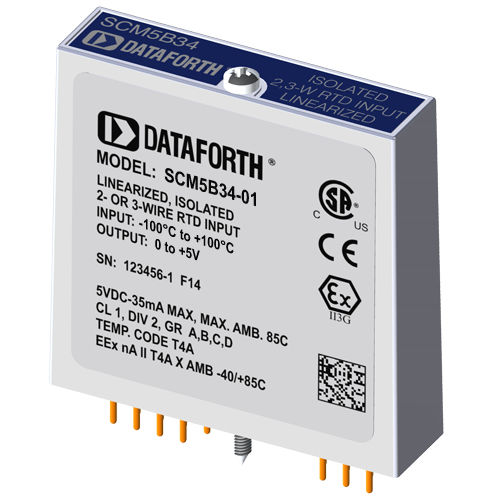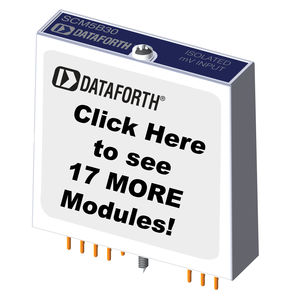
- Robotics - Automation - Industrial IT
- Automation
- RTD input module
- Dataforth Corporation
RTD input module SCM5B34-01insulated
Add to favorites
Compare this product
Characteristics
- Applications
- for RTD
- Other characteristics
- insulated
Description
Each SCM5B34 RTD input module provides a single channel of RTD input which is filtered, isolated, amplified, linearized, and converted to a high-level analog voltage output. This voltage output is logic switch controlled, which allows these modules to share a common analog bus without the requirement of external multiplexers.
The SCM5B modules are designed with a completely isolated computer side circuit which can be floated to ±50V from Power Common, pin 16. This complete isolation means that no connection is required between I/O Common and Power Common for proper operation of the output switch. If desired, the output switch can be turned on continuously by simply connecting pin 22, the Read-Enable pin, to I/O Common, pin 19.
RTD excitation is provided from the module by two matched current sources. When using a three-wire RTD, this method allows an equal current to flow in each RTD lead, which cancels the effects of lead resistances. The excitation currents are very small (0.25mA for 100 Ohm Pt and 120 Ohm Ni, and 1.0mA for 10 Ohm Cu) which minimizes self-heating of the RTD.
Signal filtering is accomplished with a six-pole filter which provides 95dB of normal-mode rejection at 60Hz and 90dB at 50Hz. Two poles of this filter are on the field side of the isolation barrier, and the other four are on the computer side. After the initial field-side filtering, the input signal is chopped by a proprietary chopper circuit. Isolation is provided by transformer coupling, again using a proprietary technique to suppress transmission of common mode spikes or surges. The module is powered from +5VDC, ±5%.
Catalogs
SCM5B Catalog
72 Pages
Other Dataforth Corporation products
SCM5B34-xx Linearized 2- or 3-Wire RTD Input Modules
Related Searches
- I O module
- Analog master module
- Analog I O module
- DIN rail mounted converter
- DIN rail I O module
- Compact master module
- Serial converter
- Communication module
- Compact converter
- Industrial converter
- RS-485 converter
- RS232 converter
- Analog input module
- Output module
- Power IC converter
- DIN rail input module
- Insulated I/O
- Isolated IC converter
- Temperature converter
- Ethernet communication module
*Prices are pre-tax. They exclude delivery charges and customs duties and do not include additional charges for installation or activation options. Prices are indicative only and may vary by country, with changes to the cost of raw materials and exchange rates.



